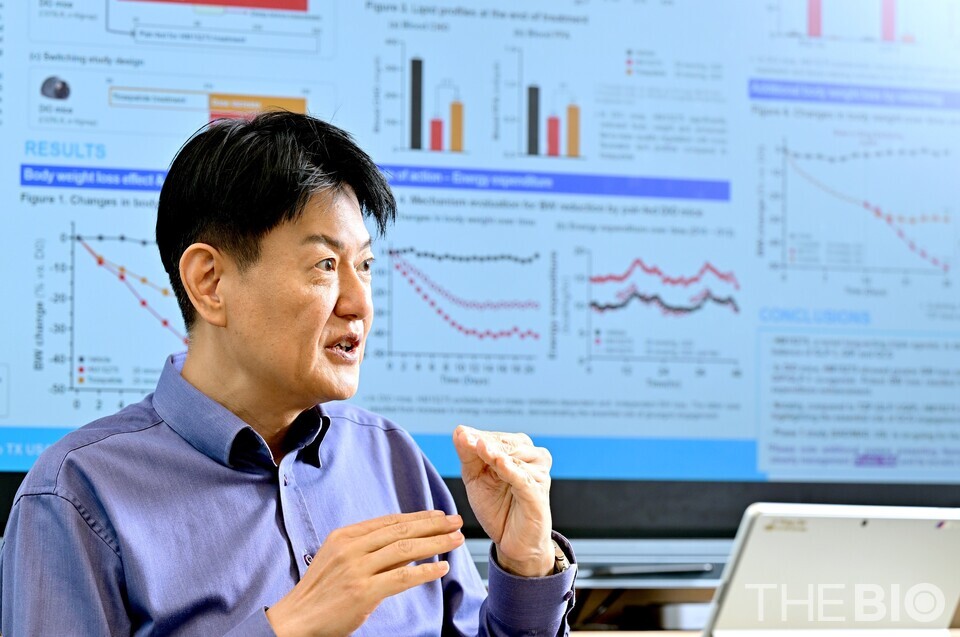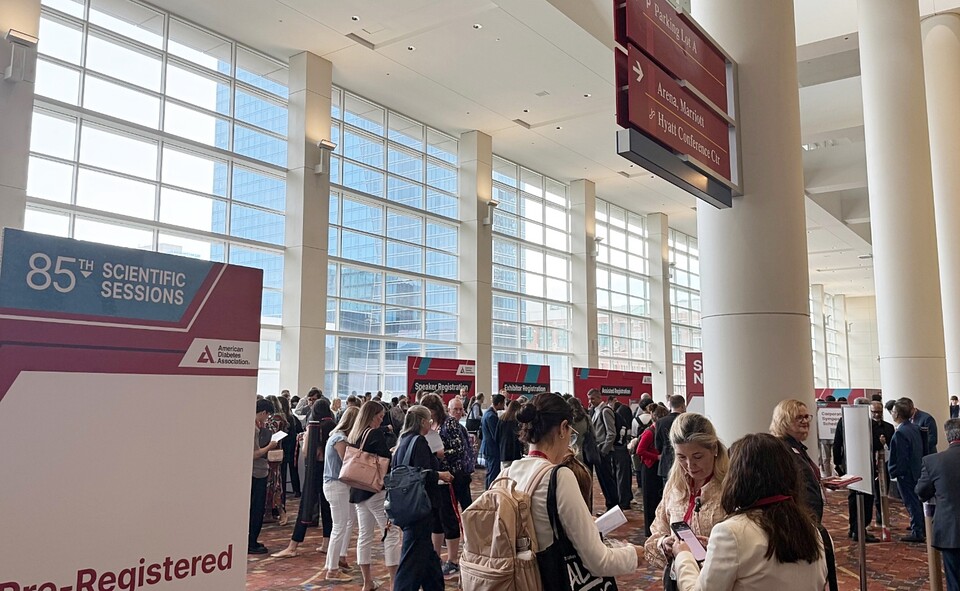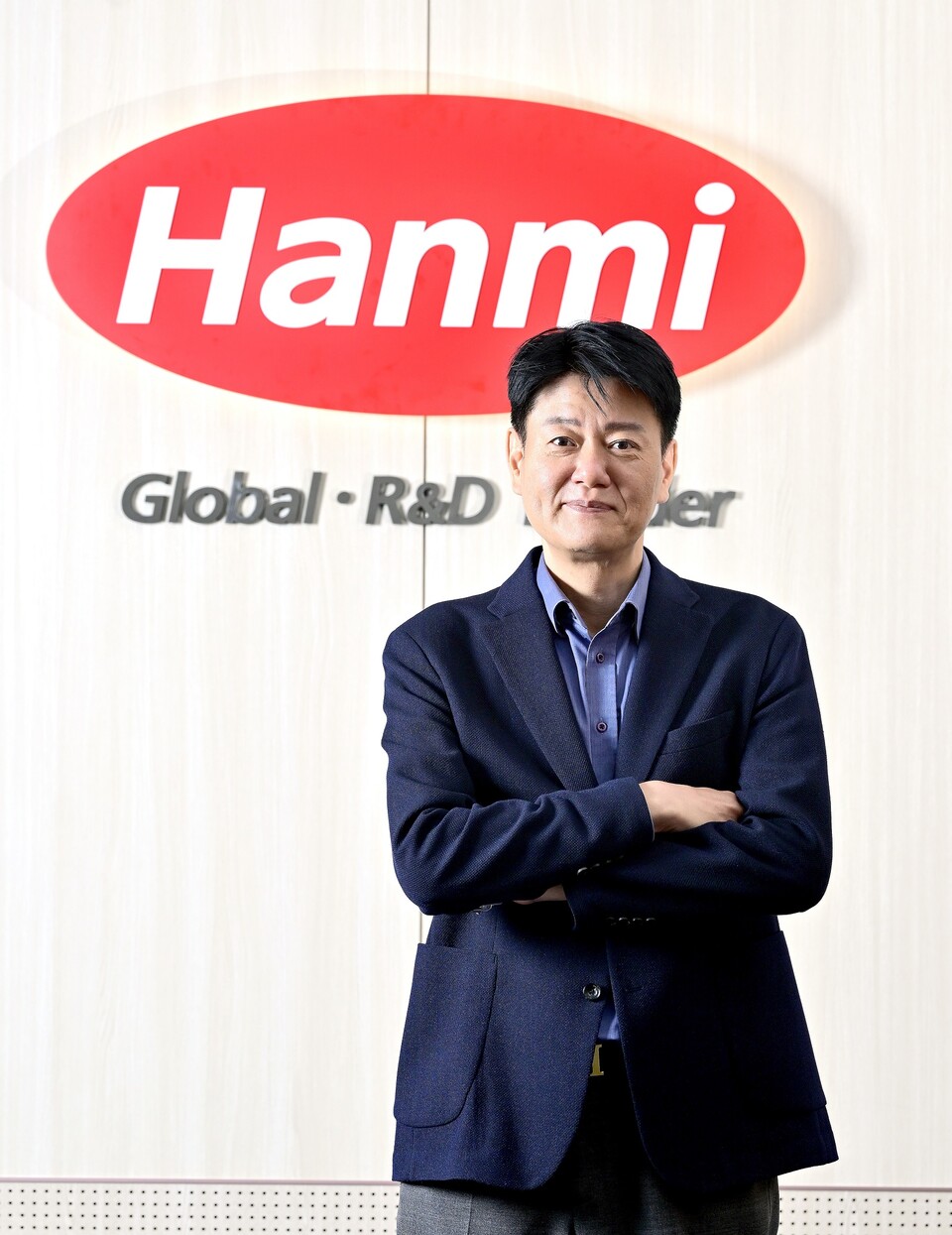- [Interview] Choi In-young, Head of Hanmi 라이브 바카라 R&D Center
- In talks for global licensing of ‘HM15275’ and ‘HM17321’ with global 라이브 바카라 companies… “Obesity pipeline’s competitiveness proven in ADA”
- “라이브 바카라 to become the next metformin… Rising demand for novel MoAs”
- “Direct showdown on the main stage… HM15275 and HM17321 entering global clinical trials”
- “Applying lessons from global deal experience with Sanofi… Strategic approach with data, clinical design, and patents”

[by Ji, Yong Jun] “Preserving muscle function during weight loss is of greater importance than the absolute reduction of 15% or 25% in body weight.”
Choi In-young, Head of Hanmi Pharmaceutical (hereinafter referred to as Hanmi Pharm)’s R&D Center, made this announcement in an interview with <THE BIO> held on July 14 at the company’s Research Center in Hwaseong, Gyeonggi Province. “The global obesity treatment market is shifting from a focus on mere weight reduction to strategies addressing ‘qualitative weight loss’ and ‘unmet needs’,” Choi emphasized. “Ongoing technology export negotiations with global pharmaceutical firms are aligned with this evolving market trend.”
Hanmi Pharm has unveiled its next-generation obesity treatment strategy centered on ‘Next GLP-1.’ The company is expediting its global technology export efforts through two key new drug candidates (development code names HM15275 and HM17321) by emphasizing a ‘qualitative weight loss’ approach aimed at reducing fat while preserving muscle mass and function. These pipeline assets are slated to enter global Phase 2 and Phase 1 clinical trials, respectively, in the second half of this year. Supported by data presented at the American Diabetes Association (ADA 2025) meeting, Hanmi Pharm is currently engaged in technology export negotiations with multinational pharmaceutical firms.
With GLP-1 anticipated to become a widely accessible ‘basic weight loss agent,’ akin to the role of ‘metformin’ in diabetes management, the growing global demand for novel obesity treatment mechanisms of action (MoA) that can complement or potentially replace GLP-1 represents a favorable development for Hanmi Pharm.

◇Hanmi Pharm’s ‘quality-enhanced’ obesity assets draw increased global attention at U.S. ADA
According to Choi, global interest in Hanmi Pharm’s pipeline assets was further affirmed at ADA 2025 meeting held in June. During the event, the company highlighted the key findings from the Phase 1 clinical trial of ‘HM15275’ and showcased the competitive potential of ‘HM17321,’ a UCN2 analogue positioned as a first-in-class novel drug within its category.
Phase 1 clinical trial results for HM15275 demonstrated excellent safety and tolerability profiles, alongside pharmacokinetic properties supporting once-weekly administration. In the highest dose cohort (0.5-2-4-8mg), participants exhibited an average weight reduction of 4.8% on day 29 following four administrations, compared to the placebo group.
“The most significant advantage of HM15275 lies in its ability to induce ‘qualitative weight loss’ by minimizing muscle loss while reducing overall body weight,” Choi stated. “The poster presentation drew such high interest that the conference hall filled to capacity, and active discussions are currently ongoing regarding technology exports and partnerships with global pharmaceutical companies.”
At the ADA 2025 conference, Hanmi Pharm also presented non-clinical data on HM17321, a next-generation 라이브 바카라 treatment candidate currently under development. HM17321 is a UCN2 analog that selectively targets the corticotropin-releasing factor 2 (CRF2) receptor. The candidate has demonstrated not only fat-reducing effects but also the ability to increase muscle mass and enhance physical function. Preclinical studies confirmed increases in skeletal muscle size, muscle fiber cross-sectional area (CSA), and improvements in muscle strength and exercise capacity. Choi explained that such functional improvements have not been observed with existing competing drugs.
“In particular, the comprehensive function-enhancing effects of HM17321 have garnered attention in light of disappointing outcomes of obesity antibody candidates such as Eli Lilly’s ‘bimagrumab’ and Regeneron’s ‘trevogrumab + garetosmab,’ which failed to demonstrate improvements in exercise capacity and were associated with safety concerns, including elevated liver and pancreatic enzyme levels,” Choi further noted.

◇Why Hanmi Pharm’s obesity assets are in the spotlight in the global market
As Hanmi Pharm positions itself to pioneer a new segment in the obesity treatment market, the global trend among major global pharmaceutical companies toward prioritizing ‘quality’ obesity therapies is anticipated to bolster the company’s technology export strategy. Notably, while current GLP-1-based treatments such as ‘Wegovy’ and ‘Mounjaro’ primarily target disease management, increasing attention is being directed toward ‘qualitative therapeutic attributes’ such as ease of administration, muscle preservation, and functional improvement, which are now emerging as key criteria for new drug development.
Choi projected that GLP-1-based therapies will serve as the ‘starting point’ in the global obesity treatment landscape. Similar to how ‘metformin’ has become the standard first-line treatment for diabetes, GLP-1 is expected to be widely adopted as the first-line treatment option for most patients with obesity.
“Now, qualitative weight loss agents, new mechanisms of action, and candidates with potential for combination use, capable of replacing or complementing existing therapies, will be increasingly valued in the global market,” Choi emphasized. This trend underpins the ongoing competition among leading pharmaceutical companies such as Novo Nordisk and Eli Lilly to develop and introduce new therapeutic substances beyond GLP-1.
Obesity treatment has traditionally relied heavily on body mass index (BMI), a metric that presents limitations in both diagnosis and prescription. Moreover, diagnostic criteria for obesity vary by country. For instance, obesity is defined as a BMI of 30 or higher in the United States, 27 or higher in China, and 25 or higher in Korea. In this context, Choi emphasized, “Diagnostic standards and treatment strategies for obesity will increasingly diversify according to national, racial, and environmental factors,” adding, “The market will inevitably shift toward personalized treatment approaches tailored to specific obesity phenotypes.”
Hanmi Pharm has secured multiple patent registrations for 라이브 바카라 treatment candidates, encompassing not only the GLP-1 series but also new MoAs. In particular, the company is demonstrating world-class technological competitiveness, on par with Novo Nordisk and Eli Lilly, based on its high citation index in the field.
◇HM15275 to enter Phase 2 and HM17321 Phase 1 Clinical Trials in H2 2025
“We plan to initiate the global Phase 2 clinical trial for HM15275 and the global Phase 1 clinical trial for HM17321 in the second half of this year,” Choi remarked. Given that it is uncommon for a Korean pharmaceutical company to independently design and locally conduct global clinical trials, this move is seen as a direct and strategic effort by Hanmi Pharm to establish a strong foothold in the global market, particularly at the pivotal stage in the evolving obesity treatment landscape.
The global Phase 2 Clinical Trial of HM15275 will also evaluate the drug’s full-scale weight loss efficacy. Choi anticipates that administration over approximately nine months will result in weight loss exceeding 25%. Choi explained that the selection of a nine-month treatment period reflects a strategic decision aimed at rapidly verifying optimal dosage and administration parameters, thereby expediting progression to the late-stage clinical development phase.
The global Phase 1 clinical trial of HM17321 is primarily designed to assess safety and tolerability. Subsequently, the trial will be expanded to include a proof-of-concept (PoC) phase, aimed at validating the drug’s mechanism of action through repeated administration for more than one month. This extended phase will focus on identifying appropriate measurement indicators and evaluating the effects of repeated dosing. In addition to monotherapy, the study will also explore the potential for a combination of switching strategies with incretin-based agents. The overarching objective is to position HM17321 as the first novel drug in the series with ‘fat reduction + muscle increase + muscle function improvement’ capabilities.
Choi particularly emphasized that the technology export experience with global pharmaceutical company Sanofi served as a pivotal learning process for Hanmi Pharm, providing critical insights into the requirements for successful clinical trials and commercialization in the global market. Sanofi had licensed Hanmi Pharm’s ‘Efpeglenatide’ for development as a diabetes treatment. However, the agreement was unexpectedly terminated during the Phase 3 clinical trial.
“This time, we are taking a far more cautious and strategic approach across all dimensions, including drug differentiation, clinical trial design, and commercialization framework,” Choi said. “We are engaging in negotiations fully equipped with the three key elements that global pharmaceutical companies prioritize: robust data, well-structured clinical design, and strong patent protection,” he added.

